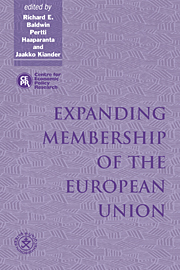1 - Introduction
Published online by Cambridge University Press: 05 November 2011
Summary
Resurgent European integration
In 1985, an unkind observer could have referred to the European Economic Community as a glorified customs union held together by a protectionist agriculture policy. Just 10 years later, the depth and breadth of the Union's economic integration goes far beyond anything seen in modern times. EU membership rose from nine to 15 members, expanding the number of EU citizens by 25 per cent. Concomitantly, microeconomic integration has been radically deepened and further macroeconomic integration is in the works. The European Union is now the vanguard of regional integration.
Deeper and wider European integration cannot be considered a parochial affair, given Europe's economic size. The nations now participating in European integration account for half of world trade and a quarter of world GDP. Indeed since the EU's trade rules directly govern one-third of world trade, they rival the importance of the General Agreement on Tariffs and Trade (GATT). The economic weight of Europe also means that European integration has an unavoidable impact on the global trading system. Moreover, the factors that foster preferential market opening in Europe also operate in the rest of the world, so regional integration is on the rise world-wide. Because European integration has gone much further and faster than the other regional arrangements, the problems facing Europeans today are likely to reappear in other regions in the future.
This volume focuses on the issues raised by expanding EU membership. While the economics of deeper integration cannot be completely separated from that of wider integration, EU expansion has brought to the forefront three new issues.
- Type
- Chapter
- Information
- Expanding Membership of the European Union , pp. 1 - 22Publisher: Cambridge University PressPrint publication year: 1995
- 1
- Cited by



